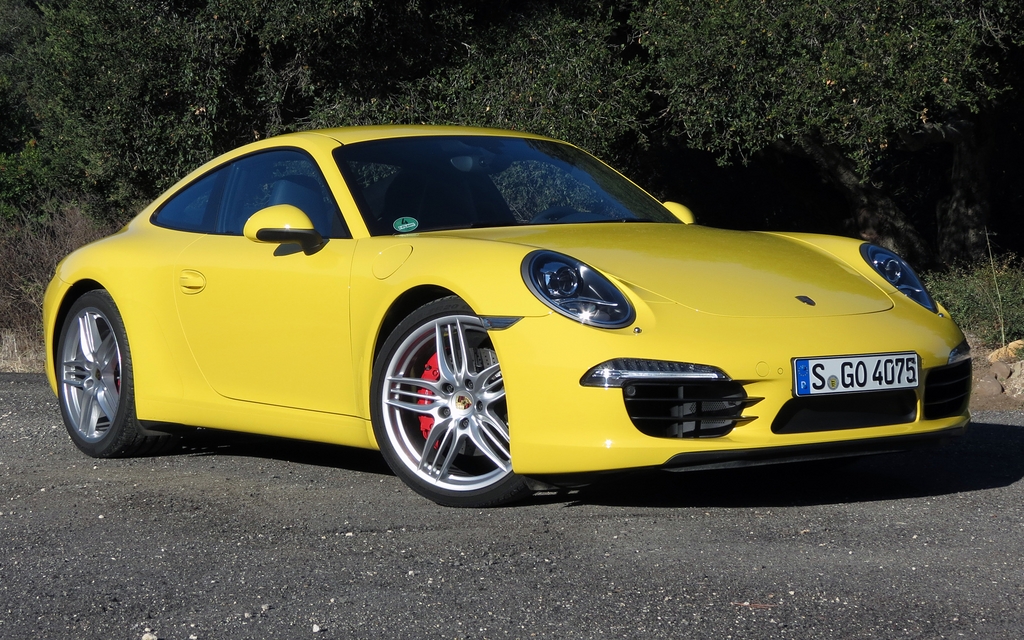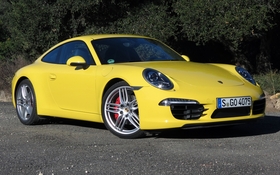The New Porsche 911: Too good to be true!
The 911 is the unassuming star, the marathon runner and the improbable monarch of sports cars. Seemingly destined to fail with its flat engine perched behind the rear axle, it has somehow managed to become the delight, the fascination and the obsession of several hundreds of thousands of driving and mechanical enthusiasts for nearly 50 years.
In fact, more than 700,000 people own a 911, if you include only those people who had the means to buy themselves a brand-new 911, fresh off the assembly line at the Zuffenhausen plant in Stuttgart. The fact that 80% of these cars are still road-worthy only adds to the vehicle’s mystique.
But how many of us dream of owning the Porsche 911? Millions. This car’s legendary reputation was built on countless victories on the world stage. Even in the hybrid version! The 911 was the proud champion of the Monte Carlo Rally and the Paris-Dakar Rally – twice! It defies all apparent logic and the laws of physics, as its power lies in the hands of pilots who are as brave as they are brilliant, not to mention a little crazy.
Equally bold are the engineers who stubbornly kept improving and refining what can be described as Porsche’s soul. They worked at it tirelessly, even though they had already demonstrated their expertise with the central engine on the Boxster, Cayman and Carrera GT. And even though they had already done the same with the front-mounted engines on the 928, 944, 968 and Panamera.
Profile to be reckoned with
That’s what comes to mind when you see the new 911, set to arrive in spring 2012 with 95% new components. This marks the sixth generation since the vehicle’s 1963 launch, and its code name is 991 even though it’s succeeding the 997, produced since 2005. Porsche will do the same thing for the next Boxster, which will be coded 981 and will replace the current 987.
This new 911 looks a lot like the previous version. Obviously, Porsche has to preserve its legendary shape with letting the vehicle evolve. The changes are significant and include an extra 100 mm on the wheelbase for improved agility, stability, a comfortable ride. Plus this makes for more room in the passenger cabin. Overall, the body is only 56 mm longer because the front and rear overhangs have been reduced by 32 and 12 mm, respectively.
The new 911 remains remarkably compact for a large sports car, but it has more presence, particularly from the side, with its longer wheelbase, larger wheels, and roof line that has been dropped by 7 mm. Carreras now come factory standard with 19-inch rims, while you’ll find 20-inch rims on the Carrera S.
In general, body lines are a little rounder and the larger front air intakes evoke those of the current Turbo and GTS. The oval blocs of the xenon headlamps are also larger. The tail end is more streamlined and reminiscent of the Panamera, although the shapely fenders and the plunging roofline are pure 911 tradition.
Although it doesn’t seem possible, the new and old versions are actually identical in width. The reason why the new version looks wider is that the Carrera’s front track is 46 mm wider and the Carrera S’s track width is 52 mm wider. Put them side-by-side and view them from the front, and the difference is striking. It’s a perfect optical illusion. You’ll also notice new rearview mirrors mounted on the doors rather than at the base of the front uprights to reduce noise and fine-tune the aerodynamics. The windshield is a little rounder too, for the same reasons.
Overcoming paradoxes
Despite its superior size and upgraded equipment, the new 911 is lighter than the previous version by 30 to 45 kg, depending on the version. The secret is a self-supporting body that has shed 80 kilos thanks to the fact that it’s half made of aluminum (on the doors, hoods, fenders and the roof).
The new body is 20% more rigid in torsion, 13% more rigid in flexing and more spacious. You get 25 mm more legroom in front and 6 mm in back. Despite the lower roofline, there’s the same amount of headroom and even 15 mm more if you add the sunroof that now slides to the outside.
The passenger compartment sees the most significant changes, beginning with a new raised central console (again reminiscent of the Panamera but for which Porsche claims to have drawn inspiration from the Carrera GT). There are a series of controls in front of the selector or stick shift, whatever the case may be.
Squeezing in just behind are numerous buttons for the climate and audio control, with a large overhanging 7-inch touch screen to control all of the above. Between the spokes of the steering wheel, set your eyes on an updated version of the 911’s classic quintet of overlapping indicators, including one information display. With so much stitched leather and satin-finished aluminum mouldings, the 911’s interior presentation has clearly moved away from its own tradition, taking an unquestionably modern stance.
More is less, and less is more
As you’d expect from Porsche, the mechanical progress is just as significant. The Carrera’s engine is a flat-six whose displacement has been reduced from 3.6 to 3.4 litres while its power has increased from 345 to 350 horses and its fuel economy has improved by 13% or 16%, depending which gearbox you choose (manual or automatic). The Carrera S still features a 3.8-litre engine but now climbs from 385 to 400 hp and its fuel economy improves by 10 or 15%.
The new 911s are also the first to offer a seven-speed manual transmission. The gear assemblies and reductions are almost identical to those of the automatic twin-clutch PDK gearbox. The PDK’s third gear is a little shorter to maximize fuel economy in town. On the manual, the seventh gear has been reduced to close the gap with the sixth gear.
The PDK models boast somewhat better fuel economy, with 8.2 instead of 9.0L/100 km for the manual Carrera and 9.5 versus 10.6 for the Carrera S. Note that the PDK versions come with a new mode that allows you to “freewheel” in light load with the engine idling in seventh gear, reducing fuel consumption to as little as 1 L/100 km. This feature goes with “thermal management,” energy recovery and the engine’s automatic stop-start mode (offered on all the models).
The 0-100 km/hr times range from the Carrera’s 4.8 seconds (manual transmission) to the 4.1 seconds for the Carrera S (PDK gearbox and the optional Sport Chrono Package). Launch Control helps gain two tenths of a second by letting the engine speed climb to about 6,000 rpm before taking off. In the manual 911s with Sport Chrono, a “+” icon and red diodes urge you to shift into the next gear before hitting the maximum of 7,800 rpm.
Braking is harsh and powerful with larger front discs, pinched by aluminum monobloc callipers (with six pistons for the Carrera S and four for the others). More resistant and half-as-light carbon ceramic brakes are now on option, featuring yellow callipers.
Almost unflappable
The structure of the suspensions is the same but the front struts and rear multilink axles are newly designed. The PASM sport chassis that lowers the body by 20 mm and helps modify the shock absorber settings comes factory standard on the “S” and on option for the Carrera. The 911 can also be fitted with a lighter version of the PDCC system that first appeared on the Cayenne and Panamera. Its small hydraulic jacks practically eliminate roll so that all of the grip of the tires can be used in turns.
There’s also the PTV (Porsche Torque Vectoring) mechanical system for the manual gearbox and the PTV Plus electronic for the PDK that distribute torque between the left and right wheels to help the 911 pivot and enter turns more easily. The new electric power steering helps add surgical precision to all of these movements.
With the larger front track width, understeer is but a distant memory. Even on the narrow, short circuit laid out for the occasion on the grounds of the little Santa Maria Airport in California, the state where more 911s have been sold that anywhere else. The rear is more likely to come unhinged if you overdo it. The anti-skid keeps an eye on things, but you can still get yourself in a jam if you’re not careful.
Porsche brought only well-equipped Carrera S’s to the launch, so we’re looking forward to driving the Carrera, too. On the road, the new S turns out to be a sensible and comfortable GT that politely cuts its engine at each stop. Press the Sport button and it awakens. With the optional sport exhaust, recognizable by its two pairs of nickel-plated tips, the sound is huskier when the flat-six climbs toward its now 7,800-rpm maximum speed. The PDK shifts gears more harshly and the suspensions are tighter, and the Sport + button kicks it up another notch. We’ll save that for the track.
Lighter, faster, more frugal, more hip, safer and more spacious, the 911 is better than ever. Porsche has already unveiled its new Cabriolet and the other variants won’t be far behind.
And when this exceptional brand finally launches its big mid-engine sports car against the likes of the R8, Lambo and McLaren, it will be able to once again offer us a pure 911, metallic and visceral like that rare 300-hp 1000-kg SC RS that came from the Porsche Museum and is a quarter-of-a-century old that they had the excellent idea of letting us drive.
You find the 911’s true soul at the wheel. Coupled with modern techniques, it promises to be fantastic.












